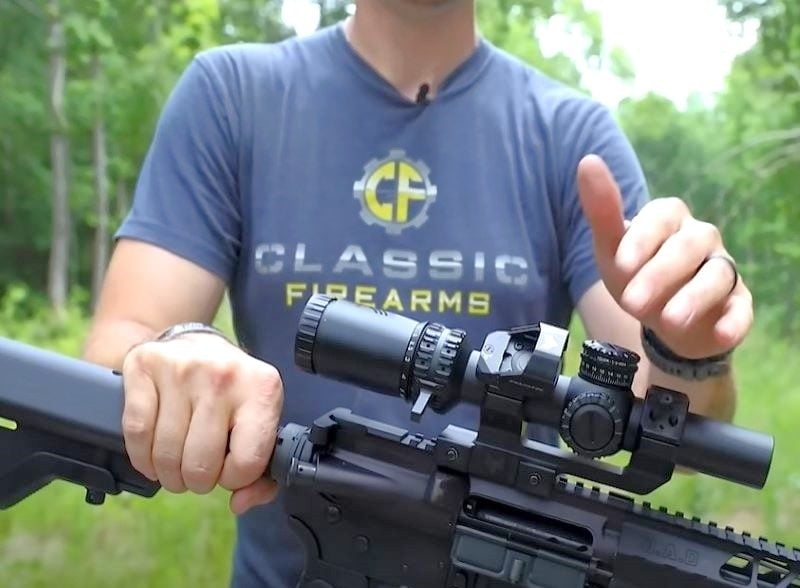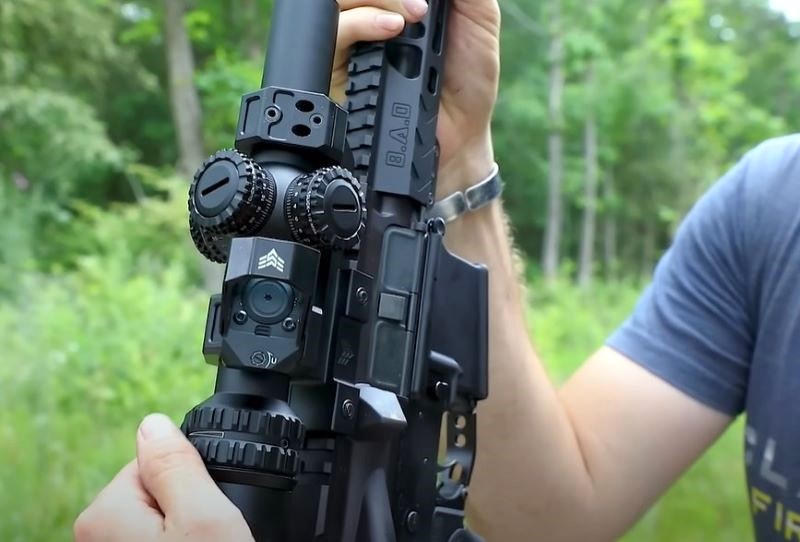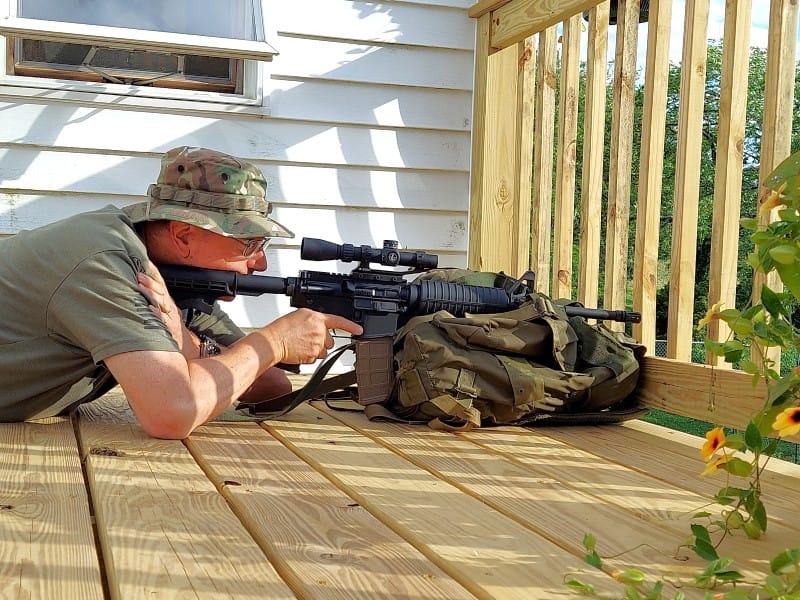Have you wondered whether a red dot sight (RDS) with a magnifier would be better than an LPVO (Low Power Variable Optic), or vice versa? What are the advantages and disadvantages? Clint Morgan with Classic Firearms [YouTube channel] walks us through the particulars and helps us to decide.
For this comparison, Clint uses the Swamp Fox 1-10x LPVO. Typically, an LPVO these days will not have a large objective lens (24mm is common). Most start out at 1 or 1.5 power, and they can go up to 10 power, although many do not go as high as 10x; 6 or 8 power is more common.
For the red dot sight and magnifier combo, Clint is using an Aimpoint RDS with a 2 MOA dot, teamed up with an Eotech 3x magnifier. The magnifier is on a cantilever mount, which facilitates it being able to be swung out and away from the RDS in the event the operator does not want magnification. If magnification is desired, the magnifier is swung back in line with the RDS.

Clint says he used to think it was a good idea not to mix manufacturers’ optics. In other words, if he’d be running a Trijicon MRO, he would also use a Trijicon magnifier. If he’d be running an Eotech holographic sight, he’d want an Eotech magnifier. That said, he stated that most optics work well with each other, even if they are from different companies. “If it works, it works, and that’s all that matters,” opines Clint. I tend to agree—who cares what label is on the optic, if it gets the job done, so be it.
What are the benefits of a magnifier and RDS over an LPVO?
- Magnifiers have been in the game for a very long time.
- LPVOs are newer and haven’t been around as long.
- The operator can quickly switch between a red dot and magnification.
- The red dot is great for quick target acquisition.
- Red dots are simple to use: aim, pull the trigger.
- Magnifier can be quickly flipped over and allows target identification.
- Switching from the RDS to magnification is very fast.
- Magnifier has a quick detach mount, so it can be installed or removed quickly.
- The eye relief is very forgiving.
What are the disadvantages of an RDS and magnifier?
- The reticle is not etched, so it’s dependent on the battery. If the battery dies, you have no optic.
- More narrow field of view as opposed to an LPVO.
- You have two optics, which means more money output.
- Two mounts—again, more money output.
- With two optics, there is twice as much to break.
What are the advantages of an LPVO?
- Very good at close quarters.
- Etched reticle, so even if the power dies, the reticle will still function.
- At 1x, you can choose whether or not to illuminate the reticle (depending on light conditions).
- Because of the large objective lens, there is a large field of view. Larger than with an RDS.
- Many magnifications to choose from.
- Higher power magnification allows target ID and engaging targets at farther distances as opposed to the RDS/Magnifier.
- It’s simpler—one optic to deal with.
What are the disadvantages of an LPVO?
- Not known for their durability compared to some RDS sights.
- The eye relief is not as forgiving as an RDS/Magnifier, which means it might take a little more time to get on target.
- Adjusting the power level takes time.
Some Thoughts
Clint believes that, if we’re going to be engaging targets more at distance, the LPVO is the better choice. He mentions that running two different optics (RDS & Magnifier) can get costly. Of course, we can spend a chunk of money on an LPVO as well, ranging from a few hundred dollars to several thousand.
The LPVO’s higher magnifications are really nice to have in many instances. In the Swamp Fox mount that he’s using, Clint has mounted a small RDS on the side at an angle, so he has the best of both worlds. In the event that there’s very close contact, he can switch to that little RDS by merely canting the rifle to the side slightly. This is especially useful if we are at high magnification and a threat presents itself close up.

Running Drills To Compare
RDS/Magnifier
Clint ran some drills, starting with the red dot sight and magnifier first. He engages the near target using the RDS without the magnifier, then flips the magnifier over and engages another target that’s about 80 yards away. It seems to go fairly smoothly with reasonable speed. He then engages at a longer range first, flips off the magnifier, and engages at a short range. Again, it goes smoothly.
I will jump in here with some thoughts on this. It’s all well and fine when it’s daylight and the targets are known. Clint knew he’d be engaging targets near and far (he even knew the exact range of the targets), at his preset choice. It’s a bit different when threats do not cooperate, as they have a nasty habit of surprising us and even have the audacity to shoot back. In such circumstances, having to flip that magnifier on and off adds additional movements to our routine. Can we afford to invest more time when the action is hot and heavy? That’s debatable. Maybe not.

LPVO
Next, Clint ran some drills with the LPVO. He engaged the near target, adjusted the power higher, and then engaged the more distant target. He tried the drill again, engaging the close target at 1x, then turned it up to 10x for the 80-yard target, at which point he had a little trouble finding the target.

Personally, I would not have turned up the power to 10x for that short range, as it is too much. I actually think leaving the scope set at 1x would be fine for engaging an 80-yard target, as it’s not that far away. It cuts the time it takes to adjust the power ring out, and I believe that saving the time would outweigh high magnification.
Clint ran it again, this time only turning the power up to 3x. It seemed to work more quickly, as he didn’t have difficulty finding the target when the power was set lower. I think that was a much better decision, as he had a wider field of view and could pick the target up fast.
An alternative would be to have the scope set at 3x and engage both targets using that power range.
The next drill that Clint runs is to engage the far target at 10x and then transition immediately to the red dot sight mounted on the side of his scope. That seemed to run pretty smoothly.

Conclusion
Clint wraps up the video by stating he likes the red dot sight and magnifier combo over the LPVO. He believes the RDS combo is superior for engaging targets at the usual distances that he does (200-250 yards) because it’s simpler. He says that running out to 200 using only an RDS (without a magnifier) is feasible, and he believes that shooting at 400 or more yards would be best accomplished using an LPVO.
I’ve used an RDS/Magnifier combo and they are nice. As I said, though, they get costly very quickly, with having to purchase two optics and two mounts. And cantilever mounts, given their complexity, do not typically come cheap.
The LPVO, on the other hand, only requires one mount and one optic, which gives us a chance to keep the cost more modest. With the LPVO, I can have the power set low in anticipation of close contact. In the event of a more distant engagement, it’s not difficult for me to add some more power to deal with those types of threats.
Personally, I think the edge goes to the LPVO. On my AR-15, I have mounted a Leupold 1.5-4x Mark-AR LPVO and it works great. It is not illuminated, which is perhaps the only downside of the optic. On the other hand, that’s one less thing that will be able to go wrong with it.

That said, I think that whichever choice you go with, you’ll be well served. The key is to get out there and practice with whatever you choose. Of course, buy the highest quality that you can afford. On the other hand, don’t expect fancy, expensive gear to make up for a lack of practice. Training and practice are vital.
How about our readers—we’d love to hear from you! Which do you prefer, and why?


